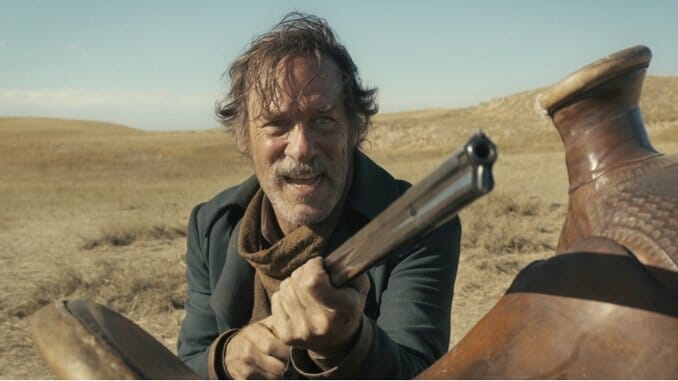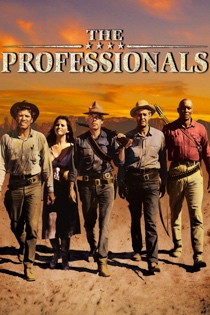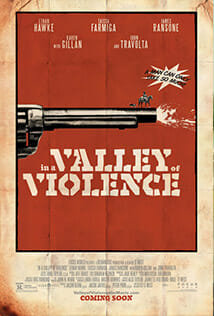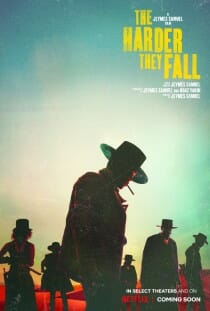
Netflix’s selection of streaming Westerns used to include many of the classics that appear on our list of the 100 best Westerns of all time. Now, we can only recommend seven of their paltry 18 total films categorized as Westerns, including three Netflix originals. If you’re looking for good-guy sheriffs, outlaw villains and stand-offs at high noon, you should enjoy all seven of the films below.
Here are the best Westerns on Netflix:
1. The Professionals Year: 1966
Year: 1966
Director: Richard Brooks
Stars: Burt Lancaster, Lee Marvin, Robert Ryan, Jack Palance, Claudia Cardinale
Rating: PG-13
A dream team of tough guys is enlisted by a rich old Texan to abduct the millionaire’s young wife back from a former Mexican Revolutionary in this spirited, star-studded adventure. Each hired hand has a specialized area of expertise: Army vet Lee Marvin knows weapons, Burt Lancaster does explosives, Robert Ryan wrangles horses, and Woody Strode is a skilled tracker. But as the mercenaries pursue Jack Palance’s bandit across the border, along with that paycheck from Ralph Bellamy’s tycoon, they learn that the particulars of the job are not as they seem. It’s a simple hook, thrillingly—and violently—executed. There’s terrific chemistry among the leads, Oscar-nominated writer-director Richard Brooks’ dialogue crackles, and fellow nominee Conrad L. Hall’s Technicolor images of the Southwest—practically the entire film takes place outdoors—are unsurprisingly exquisite. At one point, Bellamy’s wealthy jackass curses Marvin, “You bastard,” to which the professional replies, “Yes, sir, in my case an accident of birth. But you, sir, you’re a self-made man.” Part caper, part chase film, part traditional Western, The Professionals is fast-paced, action-packed fun. —Amanda Schurr
2. The Power of the Dog Year: 2021
Year: 2021
Director: Jane Campion
Stars: Benedict Cumberbatch, Kirsten Dunst, Jesse Plemons, Kodi Smit-McPhee, Thomasin McKenzie, Genevieve Lemon, Keith Carradine, Frances Conroy
Rating: R
Based on the 1967 novel of the same name by Thomas Savage, Jane Campion’s long-awaited return to the medium of film—following 2009’s Bright Star and her subsequent years spent working in television—feels apt for a director who has demonstrated prowess at crafting an atmosphere of acute disquiet. And so it goes for The Power of the Dog, a film with a perpetual twitching vein, carried by the ubiquitous feeling that someone could snap at any moment—until they do. In 1925 Montana, brothers Phil (Benedict Cumberbatch) and George Burbank (Jesse Plemons) are prosperous cattle ranchers but incompatible siblings. Phil is the ultimate image of machismo, brooding around the ranch ever adorned in his cowboy outfit and a thick layer of grime on his face, a rolled cigarette hanging against his lower lip; a character that acts in defiance of Cumberbatch’s past work. Phil is so opposed to anything even adjacent to what could be considered “feminine” that things like bathing, playing an instrument that isn’t a banjo and just being nice to women are the kinds of activities which might lead Phil to inquire “Fellas, is it gay if…?” on Twitter. From the castration of the bulls on the Burbank ranch, to Phil’s status as the black sheep of his respectable family, to the nature of the western landscape tied to Phil’s performance of masculinity, the subtext is so visually hamfisted that it remains subtextual only by virtue of it not being directly spoken out loud. But the clumsiness in the film’s approach to its subject matter is propped up by the compelling performances across the board—notably from Cumberbatch, whose embodiment of a gruff and grubby rancher is at first sort of laughably unbelievable in relation to the performances that have defined the Englishman’s career. But it is, perhaps, because of this very contrast to his past roles that Cumberbatch manages to fit into the character of Phil so acutely, carrying with him an inherent awkwardness and unrest in his own skin despite the terror that he strikes in the heart of someone like Rose. He’s matched by the chilling score, composed by the inimitable Johnny Greenwood (The Master, Phantom Thread), and impeccable cinematography from Ari Wegner (Zola, The True History of the Kelly Gang), which form a perfect union of tension, intimacy and isolation in a film where the sound of every slice, snip and click evokes the same distressing sensation regardless of the source. What does it mean to be a man? The Power of the Dog considers the question but never answers it. Instead, it is preoccupied with a timeless phenomenon: The suffering endured for the very sake of manhood itself. —Brianna Zigler
3. The Ballad of Buster Scruggs Year: 2018
Year: 2018
Directors: Joel and Ethan Coen
Stars: Tim Blake Nelson, Bill Heck, James Franco, Liam Neeson, Zoe Kazan, Tom Waits, Tyne Daly, Brendan Gleeson
Rating: R
As much an anthology of post-bellum adventure stories as it is a retrospective of the many kinds of films the Coen brothers have made—not to mention a scathing bit of fantasy curbed against the stories we’ve used to water down the tragedy of our country’s growth—The Ballad of Buster Scruggs tells six tales of greed, murder, mercy and the harsh mistress of blind chance, the only through line being the bleakness of the horizon America trampled to stake its imperial claim. A musty traveling showman (Liam Neeson) weighs the burden of his limbless performer (Harry Melling) against each night’s measly cash-out; a lone prospector (Tom Waits) patiently divines the vein of gold he refers to respectfully as “Mr. Pocket”; a cocky outlaw (James Franco) swings between the two sides of fate, his whole life leading to a semi-decent punchline; a disparate collection of travelers argue about the vicissitudes of faith while a bounty hunted corpse sits atop their carriage, all five heading towards some ambiguous symbolism; and the titular mellifluous gunslinger finally meets his match, making for one of the strangest sights the Coens have ever conjured. With the downhome nihilism of No Country for Old Men and Fargo, the mythological whimsy of O Brother, Where Art Thou?, the back-breaking metaphysical weight of A Serious Man or the cutting capers of Raising Arizona, the whole of The Ballad of Buster Scruggs—shot as a series of awe-inspiring vistas by DP Bruno Delbonnel punctuated by the porous mugs of the pioneers who populate them—sings to an unparalleled canon of genres and tones. That its centerpiece is a sweet romance, between a quiet young woman (Zoe Kazan) and a noble cowboy (Bill Heck) leading her wagon train along the Oregon Trail, proves that the Coens still have beautiful surprises in store more than three decades deep into their career-long odyssey of American life. —Dom Sinacola
4. Hell or High Water Year: 2016
Year: 2016
Director: David Mackenzie
Stars: Jeff Bridges, Chris Pine, Ben Foster, Gil Birmingham, Marin Ireland, John-Paul Howard, Christopher W. Garcia
Rating: R
David Mackenzie’s film gets the balance between genre and plot so right that, after a while, I forgot I was watching a genre film and simply found myself immersed in the lives of these characters. That is a tribute to not only the performances and Mackenzie’s direction, but also to Taylor Sheridan’s screenplay, which finds seemingly boundless amounts of colorful human detail and unexpected humor in what, on the surface, stands as a clichéd narrative. Hell or High Water is essentially a cops-and-robbers tale, with grizzled soon-to-retire veteran sheriff Marcus Hamilton (Jeff Bridges) and his deputy, Alberto Parker (Gil Birmingham), going after a brotherly duo of bank robbers: Toby (Chris Pine) and Tanner (Ben Foster) Howard. Sheridan’s characters are so fully imagined that, combined with actors and a director sensitive to the nuances in the script, we ultimately respond to them as flesh-and-blood people. But Sheridan—who tackled the moral difficulties of the drug war with his script for Sicario—has even bigger thematic game in mind. Hell or High Water is also meant to be a topical anti-capitalist lament, being that it takes place in a west Texas town that looks to have been decimated by the recent economic recession, with big billboard signs of companies advertising debt relief amid stretches of desolation, and with Toby driven in large part by a desire to break out of what he sees as a cycle of poverty for his loved ones, to provide a better life for his two sons and ex-wife. The film builds up to a finale that thankfully goes not for a mindlessly violent showdown, but for a tension-filled dialogue-based confrontation which plays like a meeting of minds between characters who have more sympathy toward each other than they perhaps realized. Even as two of the main characters reach a kind of truce, however, Mackenzie comes up with an even more devastating image with which to end his film: He simply moves the camera from high in the air down to a batch of grass. It’s as if Mackenzie wanted to contextualize these human dramas for us—we all end up in the ground, ultimately. Here, in Hell or High Water, is a sterling example of genre craftsmanship at its intelligent and unexpectedly affecting best. —Kenji Fujishima
5. The Hateful Eight Year: 2015
Year: 2015
Director: Quentin Tarantino
Stars: Samuel L. Jackson, Kurt Russell, Jennifer Jason Leigh, Walton Goggins, Demián Bichir, Bruce Dern, Michael Madsen, Channing Tatum
Rating: R
The Hateful Eight is a sprawling film with an intimate core and too much necessary material to trim. There’s a pomp and grandiosity to the weight of the film, and to Quentin Tarantino’s ambition in making it his way, that’s hard not to admire. More so than most marquee movies and tentpoles claiming to be “epic,” The Hateful Eight actually lives up to the word. With this whodunit—or who’s-gonna-doit—Tarantino is chiefly interested in the exchanging of barbs and threats more than he is in action. Make no mistake, The Hateful Eight is insanely violent, but it’s fixated around violent talk and violent reverie before physical violence. Tarantino may lay his timely allegory on thick, but The Hateful Eight bears it out in subtle ways, too: With distrust as the film’s prevailing manner, the notion that you cannot truly know the people with whom you’re having dinner takes on increased gravity and meaning, particularly in the climactic showdown, when all is revealed and we see the film’s various humans for who they truly are. Frontier justice does quench our thirst, but the themes of social justice that drive the film are more satiating by far. It all adds up to a towering work, as profound as it is profane. —Andy Crump
6. In a Valley of Violence Year: 2016
Year: 2016
Director: Ti West
Stars: Ethan Hawke, John Travolta, Taissa Farmiga, Karen Gillan, James Ransone
Rating: R
One of the most heartbreaking scenes of any film of 2016 was one of the most heartbreaking scenes of any film in 2014—then it was in slickly excellent Keanu Reeves mass-slaughter vehicle John Wick, and two years later it’s in Ti West’s otherwise pretty fun-filled neo-Western, In a Valley of Violence. To even mention the former means sauntering smugly into spoiler territory with the latter, but West, who’s proven he’s one of our deftest genre handlers still figuring out what he wants to do when he grows up, knows you can’t really spoil such an archetypal plot anyway. Instead, with his latest film, by giving up scares for shoot-outs, the typically horror-centric writer-director isn’t interested in re-configuring classic tropes as much as he is in rubbing those tropes against reality to see what sparks. And while In a Valley of Violence doesn’t burn the traditional Western formula to dust, it does give a cadre of impeccable character actors a wide-open sandbox to squat over and dump into. More, maybe, than any other recent revisionist Westerns, like Bone Tomahawk or The Hateful Eight, In a Valley of Violence is built around interrogating the genre’s tried and true archetypes—its cinematic language even—rather than upholding, modernizing, or (in the case of Tarantino’s take) obliterating them out of existence. Ethan Hawke finds the perfect workmanlike take on the Man With One Name, Paul, a gunslinging drifter and former Union soldier, by playing him as blankly as he can, owing his opaque demeanor to the Eastwoods and Bronsons of Sergio Leone’s classics. Meanwhile, the film is far funnier than any of its pedigree would suggest, aided in part by the arrival of John Travolta as the surprisingly rational U.S. Marshal. Like Kurt Russell in Bone Tomahawk, Travolta’s is a reassuring presence, as effortless as it is wearied, the anchor which the film’s increasingly stylized violence can never totally lift. Still, West is an impeccable craftsman, his storytelling chops as fatless and near-faultless as ever. As much could be expected from any genre director these days, really, and West is, undoubtedly, up to the task of trying his hand at any of the kinds of films he loves. —Dom Sinacola
7. The Harder They Fall Year: 2021
Year: 2021
Director: Jeymes Samuel
Stars: Idris Elba, Jonathan Majors, Lakeith Stanfield, Zazie Beetz, Regina King, Delroy Lindo, RJ Cyler
Rating: R
The importance of Black folks to the “taming” of the West is a central thrust to The Harder They Fall, both as a motivation for first-time feature director Jeymes Samuel, who grew up watching Westerns and wanted to see one starring Black people, and for the plot. The actors, visual style and musical choices elevate an imperfect script with memorable if not completely unique dialogue and scenes. The cast and performances are remarkable and it’s an aesthetically striking film with great set, sound and costume design. Real-life historical figures are treated like folk heroes, for better and for worse. The Harder They Fall has its problems, but it’s a testament to the idea that there are still interesting things to be done in familiar genres, like inserting color aesthetically and demographically. It’s worth watching at least once for the spectacle of the vibrant colors and great performances, and to be introduced to real historical characters, even if audiences must look far from the film to figure out what they were actually like. It does a great job reinserting Black people into the story of the U.S. western expansion, but it’s a qualified success because the film ignores the people the U.S. was stolen from, in places and among people where they could still be found. —Kevin Fox, Jr.